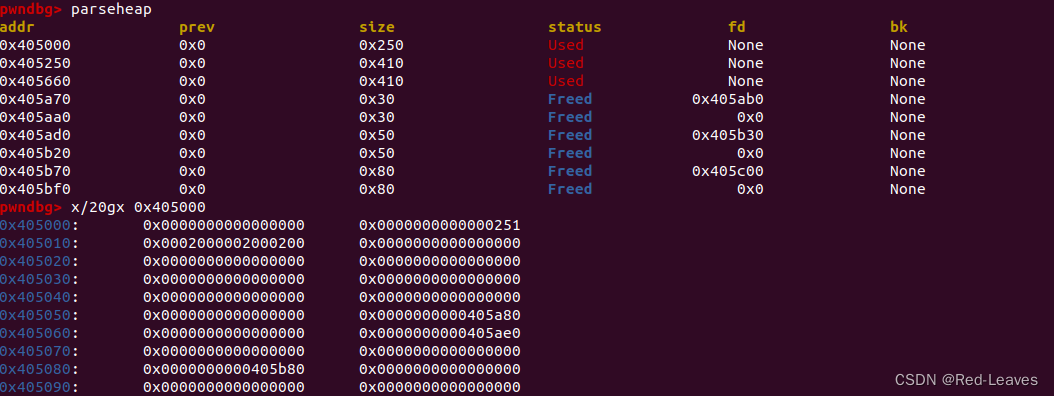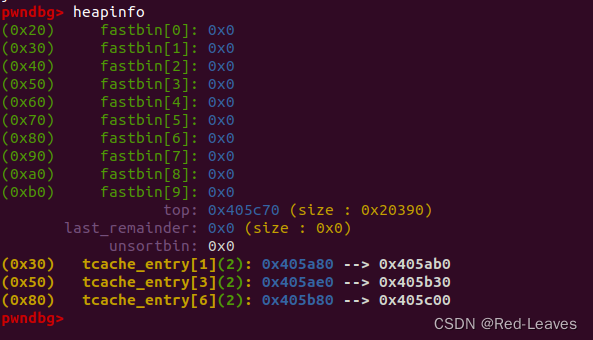Index
- 前情提要
- 过程
- 总结
前情提要
tcache_perthread_struct 是GLIBC从2.27开始引入的机制,本质就是链表。
最近我在复现CISCN往年题目,刚好想仔细研究研究劫持等的原理是什么,于是就研究了一会。
过程
找ChatGPT要了一段申请删除堆块的示例代码,然后直接开始实验。
#include <stdio.h>
#include <stdlib.h>
#include <sys/mman.h>#define MAX_CHUNKS 10 // 最大内存块数目int main() {void *chunks[MAX_CHUNKS] = {NULL}; // 存储多个内存块指针的数组size_t sizes[MAX_CHUNKS] = {0}; // 存储每个内存块大小的数组int num_chunks = 0; // 当前内存块数量while (1) {int choice;printf("选择操作:\n");printf("1. 申请内存块\n");printf("2. 删除内存块\n");printf("其他数字退出\n");printf("请输入您的选择:");scanf("%d", &choice);if (choice == 1) {if (num_chunks >= MAX_CHUNKS) {printf("已达到最大内存块数量\n");continue;}printf("请输入要申请的内存块大小(字节):");if (scanf("%zu", &sizes[num_chunks]) != 1) {printf("无效的输入\n");while(getchar() != '\n');continue;}if (sizes[num_chunks] > 0) {chunks[num_chunks] = malloc(sizes[num_chunks]);if (chunks[num_chunks] == NULL) {perror("内存申请失败");return 1;}printf("成功申请了 %zu 字节的内存块,地址为:%p\n", sizes[num_chunks], chunks[num_chunks]);num_chunks++;} else {printf("无效的大小,无法申请内存块\n");}} else if (choice == 2) {if (num_chunks > 0) {free(chunks[num_chunks - 1]);chunks[num_chunks - 1] = NULL;sizes[num_chunks - 1] = 0;printf("成功释放内存块\n");num_chunks--;} else {printf("没有内存块可删除\n");}} else {// 释放所有内存块for (int i = 0; i < num_chunks; i++) {free(chunks[i]);chunks[i] = NULL;sizes[i] = 0;}break; // 输入其他数字时退出循环}}return 0;
}
使用这段指令编译,便于测试保护全关。
gcc -o test test.c -fno-stack-protector -no-pie
首先我们需要先对tcache的源码有一定的初步了解:
GLIBC 2.27 malloc
#if USE_TCACHE/* We overlay this structure on the user-data portion of a chunk whenthe chunk is stored in the per-thread cache. */
typedef struct tcache_entry
{struct tcache_entry *next;
} tcache_entry;/* There is one of these for each thread, which contains theper-thread cache (hence "tcache_perthread_struct"). Keepingoverall size low is mildly important. Note that COUNTS and ENTRIESare redundant (we could have just counted the linked list eachtime), this is for performance reasons. */
typedef struct tcache_perthread_struct
{char counts[TCACHE_MAX_BINS];tcache_entry *entries[TCACHE_MAX_BINS];
} tcache_perthread_struct;static __thread bool tcache_shutting_down = false;
static __thread tcache_perthread_struct *tcache = NULL;/* Caller must ensure that we know tc_idx is valid and there's roomfor more chunks. */
static __always_inline void
tcache_put (mchunkptr chunk, size_t tc_idx)
{tcache_entry *e = (tcache_entry *) chunk2mem (chunk);assert (tc_idx < TCACHE_MAX_BINS);e->next = tcache->entries[tc_idx];tcache->entries[tc_idx] = e;++(tcache->counts[tc_idx]);
}/* Caller must ensure that we know tc_idx is valid and there'savailable chunks to remove. */
static __always_inline void *
tcache_get (size_t tc_idx)
{tcache_entry *e = tcache->entries[tc_idx];assert (tc_idx < TCACHE_MAX_BINS);assert (tcache->entries[tc_idx] > 0);tcache->entries[tc_idx] = e->next;--(tcache->counts[tc_idx]);return (void *) e;
}
可以看到tcache的结构体定义是这样的:
typedef struct tcache_perthread_struct
{char counts[TCACHE_MAX_BINS];tcache_entry *entries[TCACHE_MAX_BINS];
} tcache_perthread_struct;
首先是一个存储堆块数量的地方,一个存储tcache_entry指针数组的地方。
在内存中往往是大小为0x200+,通常为0x250或0x290的堆,地址16字节对齐。
如:


由于我目前一个堆块没有申请一个堆块没有释放,因此数据全是0。
现在我申请2个大小为0x20的,2个大小为0x40的,2个大小为0x70的堆块。

可以看到会在大小上加上10,这是因为这10字节大小是用来存储chunk header数据的。
然后我们全部释放。

可以看到这个堆块数据就变了。那么我们来分析一下具体是什么。
首先使用指令tcache可以查看tcache结构体的情况。


heapinfo用来查看链表。然后基于这些数据,我们来查看内存的情况。
pwndbg> x/20gx 0x405000
0x405000: 0x0000000000000000 0x0000000000000251
0x405010: 0x0002000002000200 0x0000000000000000
0x405020: 0x0000000000000000 0x0000000000000000
0x405030: 0x0000000000000000 0x0000000000000000
0x405040: 0x0000000000000000 0x0000000000000000
0x405050: 0x0000000000000000 0x0000000000405a80
0x405060: 0x0000000000000000 0x0000000000405ae0
0x405070: 0x0000000000000000 0x0000000000000000
0x405080: 0x0000000000405b80 0x0000000000000000
0x405090: 0x0000000000000000 0x0000000000000000
显而易见,0x405010地址就是用来存储堆块数量的。0x405050开始存储释放的堆块的指针。
那么0x405010和0x405050具体是如何存储的呢,我们进一步研究。
根据tcache的结果可知:
tcache is pointing to: 0x405010 for thread 1
{counts = "\000\002\000\002\000\000\002", '\000' <repeats 56 times>,entries = {0x0, 0x405a80, 0x0, 0x405ae0, 0x0, 0x0, 0x405b80, 0x0 <repeats 57 times>}
}
可以发现在0x405010中,堆块数量是2个2个存储的:
0x00/02/00/00/02/00/02/00
分别对应大小:
0x80/0x70/0x60/0x50/0x40/0x30/0x20/0x10
同时可以得出entries指针也是类似的逻辑:
0x405050开始,第一段是0x20大小的chunk,第二段是0x30,第三段是0x40…以此类推。
通常tcache_perthread_struct结构体劫持是用来泄露libc地址和布置堆块构造ROP的。也就是说我们可以手动修改entries指针来让堆块申请在我们想要的任何位置,也就是任意地址写。
总结
tcache_perthread_struct 结构体存储了可以存放的最多tcache堆块数量、已释放的tcache堆块指针。
通过劫持并修改这些,可以做到任意地址写。
如有错误欢迎大佬们提出。




![[OpenWrt]RAX3000一根线实现上网和看IPTV](http://pic.xiahunao.cn/[OpenWrt]RAX3000一根线实现上网和看IPTV)





)






(代码+详解))

